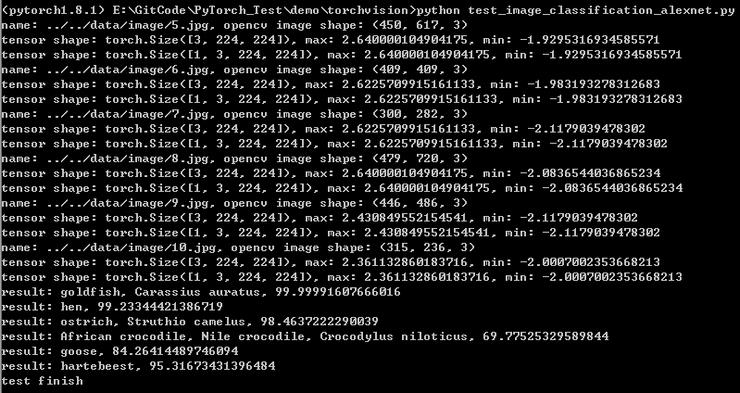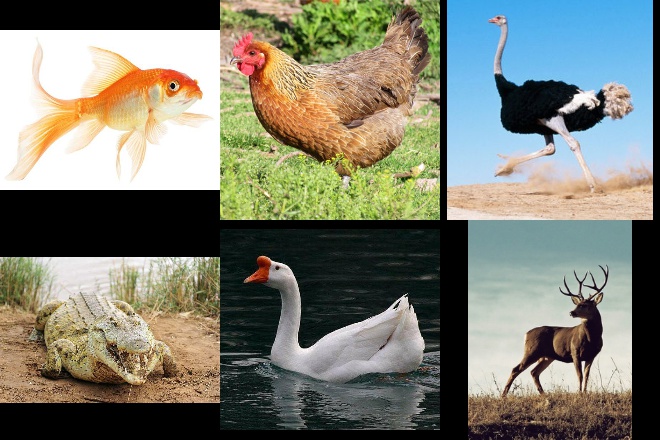TorchVision中通过AlexNet网络进行图像分类
Posted fengbingchun
tags:
篇首语:本文由小常识网(cha138.com)小编为大家整理,主要介绍了TorchVision中通过AlexNet网络进行图像分类相关的知识,希望对你有一定的参考价值。
TorchVision中给出了AlexNet的pretrained模型,模型存放位置为https://download.pytorch.org/models/alexnet-owt-4df8aa71.pth ,可通过models.alexnet函数下载,此函数实现在torchvision/models/alexnet.py中,下载后在Ubuntu上存放在~/.cache/torch/hub/checkpoints目录下,在Windows上存放在C:\\Users\\spring\\.cache\\torch\\hub\\checkpoints目录下,其中spring为用户名。
AlexNet的介绍参考:https://blog.csdn.net/fengbingchun/article/details/112709281
在推理(inference)过程中,模型的输入是一个tensor,shape需要是[1,c,h,w],原始图像进行预处理操作包括:
(1).resize到短边为256,长边等比缩放。
(2).在中心裁剪图像大小到224*224。
(3).将数据从numpy.ndarray转换到tensor;原数据shape为[h,w,c],转换后tensor shape为[c,h,w];原数据值范围为[0,255],转换后值范围为[0.0,1.0]。
(4).使用均值和标准差对tensor图像进行归一化。
(5).将tensor的shape从[c,h,w]转换到[1,c,h,w]。
模型是通过ImageNet数据集训练获得的,它的图像分类数是1000,ImageNet数据集的介绍参考:https://blog.csdn.net/fengbingchun/article/details/88606621
以下为测试代码:
import torch
from torchvision import models
from torchvision import transforms
import cv2
from PIL import Image
import math
import numpy as np
#print(dir(models))
images_path = "../../data/image/"
images_name = ["5.jpg", "6.jpg", "7.jpg", "8.jpg", "9.jpg", "10.jpg"]
images_data = [] # opencv
tensor_data = [] # pytorch tensor
def images_stitch(images, cols=3, name="result.jpg"): # 图像简单拼接
'''images: list, opencv image data; cols: number of images per line; name: save image result name'''
width_total = 660
width, height = width_total // cols, width_total // cols
number = len(images)
height_total = height * math.ceil(number / cols)
mat1 = np.zeros((height_total, width_total, 3), dtype="uint8") # in Python images are represented as NumPy arrays
for idx in range(number):
height_, width_, _ = images[idx].shape
if height_ != width_:
if height_ > width_:
width_ = math.floor(width_ / height_ * width)
height_ = height
else:
height_ = math.floor(height_ / width_ * height)
width_ = width
else:
height_, width_ = height, width
mat2 = cv2.resize(images[idx], (width_, height_))
offset_y, offset_x = (height - height_) // 2, (width - width_) // 2
start_y, start_x = idx // cols * height, idx % cols * width
mat1[start_y + offset_y:start_y + height_+offset_y, start_x + offset_x:start_x + width_+offset_x, :] = mat2
cv2.imwrite(images_path+name, mat1)
for name in images_name:
img = cv2.imread(images_path + name)
print(f"name: images_path+name, opencv image shape: img.shape") # (h,w,c)
images_data.append(img)
img = cv2.cvtColor(img, cv2.COLOR_BGR2RGB)
img_pil = Image.fromarray(img)
transform = transforms.Compose([
transforms.Resize(256),
transforms.CenterCrop(224),
transforms.ToTensor(),
transforms.Normalize(mean=[0.485, 0.456, 0.406], std=[0.229, 0.224, 0.225])
])
tensor = transform(img_pil)
print(f"tensor shape: tensor.shape, max: torch.max(tensor), min: torch.min(tensor)") # (c,h,w)
tensor = torch.unsqueeze(tensor, 0) # 返回一个新的tensor,对输入的既定位置插入维度1
print(f"tensor shape: tensor.shape, max: torch.max(tensor), min: torch.min(tensor)") # (1,c,h,w)
tensor_data.append(tensor)
images_stitch(images_data)
model = models.alexnet(pretrained=True) # AlexNet网络
#print(model) # 可查看模型结构,与torchvision/models/alexnet.py中一致
model.eval() # AlexNet is required to be put in evaluation mode in order to do prediction/evaluation
with open("imagenet_classes.txt") as f:
classes = [line.strip() for line in f.readlines()] # the line number specified the class number
for x in range(len(tensor_data)):
prediction = model(tensor_data[x])
#print(prediction.shape) # [1,1000]
_, index = torch.max(prediction, 1)
percentage = torch.nn.functional.softmax(prediction, dim=1)[0] * 100
print(f"result: classes[index[0]], percentage[index[0]].item()")
print("test finish")执行结果如下:以下原始测试图像来自网络,每张图像仅输出可信度值最高的一个类别。从上往下,从左往右,每张图像的分类结果依次是:goldfish(金鱼)、hen(母鸡)、ostrich(鸵鸟)、African crocodile(非洲鳄鱼)、goose(鹅)、hartebeest(羚羊)。


以上是关于TorchVision中通过AlexNet网络进行图像分类的主要内容,如果未能解决你的问题,请参考以下文章